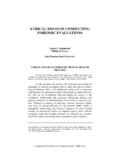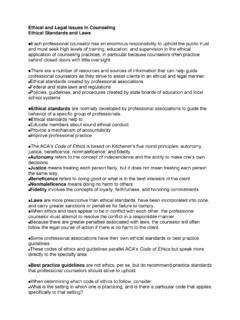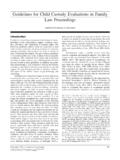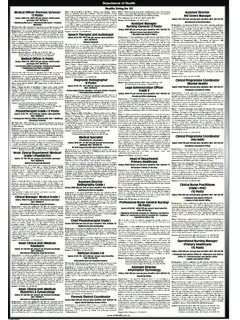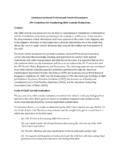Transcription of ASSESSING CREDIBILITY IN ALLEGATIONS OF …
1 ASSESSING CREDIBILITY IN ALLEGATIONS CONFLICT CHILD CUSTODY CASE OF MARITAL VIOLENCE IN THE HIGH- William G. Austin forensic psychology has not systematically examined the problem of evaluating the CREDIBILITY of ALLEGATIONS of marital violence within the context of a child custody case. The importance of this issue stems from the negative effect of family violence on children, the iniplications for parenting effectiveness, and consideration of the feasibility of joint custody. When marital vio- lence has not been previously disclosed or objectively documented by prosecution, there is a need to examine the CREDIBILITY of the ALLEGATIONS because of the strategic incentive for both sides to distort historical events.
2 A six-factor model is presented to assist the child custody evaluator and judicial decision maker in this task. A risk assessment approach to marital violence in the custody evaluation context is presented. The need to examine the empirical basis of marital vio- lence ALLEGATIONS in custody litigation should not discourage victims from raising the issue and does not diminish the seriousness of family maltreatment as a social problem. THE PROBLEM There may be a strategic advantage in contested child custody cases for one party to be viewed as the victim of marital violence and for the other part- ner to claim to be falsely accused of being a perpetrator or that at least the relationship was characterized by reciprocal violence.
3 Because a high per- centage of both men and women in contested custody cases report being abused in the marriage (Newmark, Harrell, & Salem, 1994) and at nearly equal rates (Straw, 1979), it is to be expected that issues of marital violence will frequently be raised in the context of child custody evaluations. The risk exists that these claims may be exaggerated or fabricated, either in the asser- tion or denial of violent acts and especially in cases where both parents may have been violent. Some practitioners assert that false allegation of domestic violence is a growing problem (Stahl, 1994), but there is no research to sug- gest that it is common for a parent to falsely assert a claim of marital violence (Jaffe & Geffner, 1998).
4 Because verbal reports in a forensic context are sub- ject to frequent distortion, there is a need for child custody evaluators to have a systematic and rational method to ascertain the CREDIBILITY of the ALLEGATIONS FAMILY AND CONCILIATION COURTS REVEW. Vol. 38 No. 4, October 2000 462-477 Q ZOO0 Sage Publications, Inc. 462 Austin / ASSESSLNG CREDIBILITY 463 when they do arise. forensic clinical methodology has not yet addressed this issue. There may be situations in which violence is alleged to have occurred in a marriage, but there are no data to corroborate the violence. If the evaluator finds the alleged victim s description compelling and the denial not very believable, he or she must acknowledge the limits of the interpretation, even when abuse is suspected.
5 Professional guidelines for conducting child cus- tody evaluations are clear on this issue (American Psychological Associa- tion, 1994; Committee on Ethical Guidelines for forensic Psychologists, 1991). Melton, Petrila, Poythress, and Slobogin (1997) issue the following caution on child custody evaluations: There is probably no forensic question on which overreaching by mental health professionals has been so common and egregious (p. 484). There is no reason this warning should not apply to the issue of marital violence. The clinical procedural rule is that the evaluator needs to be true to the sufficiency of the data on this issue as he or she would with any relevant issue in the child custody case.
6 Research shows that the overall prevalence rate of marital violence is approximately 12% has been stable over time, and supports the empirical generalization that both sexes initiate violent acts, even serious ones, with equal frequency (Gelles & Strauss, 1988). In higher risk populations, such as recently released psychiatric patients, marital violence rates are higher; in one study, the rates were 42% for men and 49% for women (Lidz, Mulvey, & Gardner, 1993). These data do not diminish the reality that harm potential for the female victim is higher, with men causing more serious physical harm, or that much of female violence may be in self-defense (Holden, Geffner, & Jouriles, 1998).
7 The base rate data on marital violence and the nature of violence predic- tion create several implications for the child custody evaluator. First, it would be expected that marital violence would be a frequent issue in contested cus- tody cases, as practitioners have suggested (Johnston & Roseby, 1997). Sec- ond, a pattern of interactive marital violence would not be uncommon, as opposed to the dichotomous stereotype of the man as the sole initiator of vio- lence in the relationship. The work of practitioner-clinical theorists suggests that the stereotype of the dominating male batterer is too simplistic and that there is a typology of observed marital violence scenarios (Johnston & Campbell, 1988, 1993; Gould, 1998).
8 Third, the subtype of interactive mari- tal violence may be a complex one to unravel in the individual case. Research suggests that clinical judgment may add only a modest amount of predictive utility to harm-doing potential because of the tendency of clinicians to under- estimate the rate of female-initiated violence (Lidz et al., 1993). Fourth, if the evaluator feels confident that the data support a conclusion that marital vio- 464 FAMILY AND CONCILIATION COURTS REVIEW lence occurred, opinions and recommendations need to inform the court on the frequency and seventy of the violence, the subtype or pattern of violence, and how the violence potential may affect parenting and the children in the future.
9 LEGAL CONTEXT AND WORKING HYPOTHESES Some states specifically address the implications of marital violence for child custody decisions. Colorado employs a statutory presumption against awarding joint legal custody to a party who has been a perpetrator of spousal violence (Colorado Revised Statutes, 1999), and a national judicial organiza- tion proposes this presumption for joint or sole custody (National Council of Juvenile and Family Court Judges, 1994). This presumption is based on the plausible hypothesis that a relationship with a history of marital violence will likely act as a hindrance to the type of co-parenting expected in a joint cus- tody arrangement and that this is likely to be the case even when the form of violence was initiated by both partners (Clingempeel & Reppucci, 1982; Johnston, 1995).
10 The literature suggests that a perpetrator of marital violence is likely to be a less effective parent because exposing children to domestic violence is a form of emotional abuse (Jaffe 8z Geffner, 1998). A history of marital violence predicts a poor prognosis for parenting cooperation (Johnston & Roseby, 1997), and the likelihood of interparental conflict has consistently been shown to interfere with child adjustment to divorce (Felner, Terre, & Rowlison, 1988). MARITAL VIOLENCE AS A RISK FACTOR IN CHILD CUSTODY DETERMINATION The presence of marital violence can be treated as a risk factor in predict- ing potential harm to children in the custody determination.
